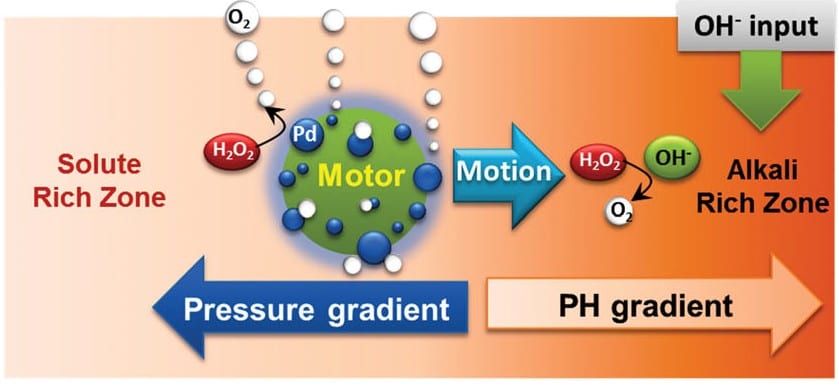 Scientists have developed autonomous catalytic microrobots that swim towards a specified target with a speed of 20 body lengths per second.
Scientists have developed autonomous catalytic microrobots that swim towards a specified target with a speed of 20 body lengths per second.
In nature, microscopic biomotors are essential for cellular transduction and transport. Learning and copying from nature, scientists use the chemical and biological frameworks of such tiny motors to develop artificial micro- and nanorobots (micro/nanobots) for targeted activities in both natural and artificial environments.
Professor Chattopadhyay and his team at the Indian Institute of Technology Guwahati have now reported artificial microbots that swim autonomously towards a specific target by following a pH gradient. They designed special polymer microspheres with randomly distributed palladium nanoparticles on their surfaces. When the micro-objects are placed into a solution of water and hydrogen peroxide, the palladium nanoparticles catalyze the decomposition of hydrogen peroxide to oxygen and water. This reaction creates a local solute pressure imbalance and drives the (random) motion (taxis) of the spheres.
To direct the microbots in situ, the scientists used the pH dependence of the decomposition reaction: the more basic the solution, the faster the decomposition and, consequently, the faster the motion. The microbots sense a pH gradient, which guides the motors towards the higher pH region with increasing speed (pH-taxis). The video below shows a micro-object swimming towards a thread that punctually adds base (sodium hydroxide) to the peroxide/water solution and thus creates a pH gradient in the petry dish. The objects could also undergo random walk, translation, vertical motion, hopping or pulsed motion, depending on their size and the imposed pH gradient.
The researchers also draw attention to the speed of their novel microbots. While living organisms usually show chemotaxis of a few micrometers per second, their artificial micromotors achieve an order of ten micrometers per second, which corresponds to a speed of twenty bodylengths per second.
The versatile, autonomously moving micro/nano-objects with self-generated sensing capacity are likely to have wide applications as pH sensors, drug transporters, and alarms for industrial pollutants, etc. The pH-taxis of these in situ guided devices may open new avenues in the design and development of futuristic nanomachines outside the biological realm.

















